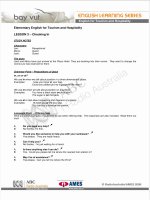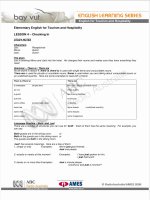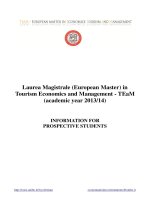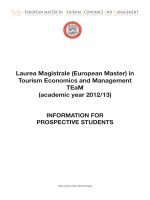sustainable tourism
Bạn đang xem bản rút gọn của tài liệu. Xem và tải ngay bản đầy đủ của tài liệu tại đây (16.8 MB, 232 trang )
Lecture 1
Lecture 1
–
–
Introduction to the
Introduction to the
sustainable tourism concepts
sustainable tourism concepts
and issues
and issues
Nguyen Thị Thúy Hồng M.A
Objectives
Objectives
1.
1.
Explain the meaning of sustainable
Explain the meaning of sustainable
development and its application to
development and its application to
tourism
tourism
2.
2.
What is meant by making tourism more
What is meant by making tourism more
sustainable
sustainable
3.
3.
Examine the Government and private
Examine the Government and private
sector relationship in promoting
sector relationship in promoting
sustainable tourism
sustainable tourism
4.
4.
Case study 1.
Case study 1.
3
3
1.
1.
Meaning of sustainable development
Meaning of sustainable development
Costs and benefits of tourism development at a
destination:
• Antalya Mediterranean City video.
• What tourism activities do you observe?
• What natural resources are utilized to develop the
tourism activities?
• What are potential negative impacts of tourism
activities on the natural resources?
• What are potential economic benefits associated
with the tourism activities?.
4
4
1.
1.
Meaning of sustainable development
Meaning of sustainable development
“Sustainable development is a process to meet the
needs of the present without compromising the
ability of future generations to meet their own
needs” – (World Commission on Environment and
Development, 1987);
• Husbandary of the world’s resources;
• Equity in using resources and distributing benefits.
5
5
1.
1.
Meaning of sustainable development
Meaning of sustainable development
Three dimensions or pillars of sustainable
development – (Aganda 21 – the plan of actions
from the UN Conference on Environment and
Development in Rio de Janeiro, 1991 – World
Summit on Sustainable Development in
Johannesburg, 2002):
• Economic sustainability – generating prosperity at
different levels of society and addressing the cost
effectiveness of all economic activities;
• Social sustainability – equitable distribution of
benefits and respecting human rights;
• Environmental sustainability – conserving and
managing resources.
6
6
2.
2.
Sustainability and Tourism
Sustainability and Tourism
Tourism is used as a vehicle to achieve sustainable
development
• Primarily concerned with satisfying the needs of
tourists and players in the industry;
• Tourism development is to be encouraged and seen
as acceptable if developing other economic sectors.
7
7
2.
2.
Sustainability and Tourism
Sustainability and Tourism
Product led tourism – environmental resources for
tourism receive consideration, but are secondary to
the growth of the tourism sector
• Justfied in communities already heavily
economically dependent upon tourism where
placing a high priority on environmental concerns
may mean the well-being of the community is
threatened.
8
8
2.
2.
Sustainability and Tourism
Sustainability and Tourism
Environmentally led tourism – types of tourism
would be promoted that are reliant upon a high-
quality environment
• The link between the success of the tourism industry
and environmental conservation;
• Attracting tourists who would wish to be educated
about the natural environment and perhaps
participate in its conservation.
9
9
2.
2.
Sustainability and Tourism
Sustainability and Tourism
Neotenous tourism – tourism should not be
permitted at all in some exceptionally sensitive
areas
• Preservation of species is paramout;
• Tourism should be limited to very small numbers
through policy control measures in other ecological
significant areas.
10
10
2.
2.
Sustainability and Tourism
Sustainability and Tourism
Tourism and sustainable development have a
special relationship. On the positive side, tourism
can:
• Provide a source for enterprise development,
employment creation and local services;
• Bringing a tangible economic value to natural and
cultural resources;
• Be a force for inter-cultural understanding and
peace.
11
11
2.
2.
Sustainability and Tourism
Sustainability and Tourism
Consersely, tourism can:
• Place a direct pressure on fragile ecosystems;
• Compete for the use of scare resources, notably
land and water;
• Be a significant contributor to the local and global
pollution.
12
12
Ninh Hong hotel: 4 family rooms (1998) – over 30 hotel
room (present)
Chua Xu Lady
Temple and Festival:
1 million visitors
annually
Voluntary working group from Dubai Int’l school to
Ban Ho, Sa Pa.
13
13
No longer find tigers in forests (Yok Don):
Waste water pollution
from silk workshops in
Van Phuc
No train ticket during the peak seasons
14
14
3.
3.
Making tourism more sustainable
Making tourism more sustainable
The term “sustainable tourism” means “tourism that
is based on the principles of sustainable
development, regardless of scales or types of
tourism. The UNWTO has given the full definition of
sustainable tourism as:
“Tourism that takes full account of its current and
future economic, social and environmental impacts,
addressing the needs of visitors, the industry, the
environment and host communities”.
15
15
3.
3.
Making tourism more sustainable
Making tourism more sustainable
Sustainable tourism should:
• Make optimal use of environmental resources;
• Respect the socio-cultural authenticity of host
communities;
• Ensure viable, long-term economic operations,
providing equitable socio-economic benefits to all
stakeholders.
16
16
3.
3.
Making tourism more sustainable
Making tourism more sustainable
Key challenges for more sustainable tourism:
• Managing the dynamic growth of the industry;
• Poverty alleviation;
• Support for conservation;
• Health, safety and security.
17
17
3.
3.
Making tourism more sustainable
Making tourism more sustainable
12 aims for an agenda for sustainable tourism:
• Economic viability
• Local prosperity
• Employment quality
• Social equity
• Visitor fulfillment
• Local control
• Community wellbeing
• Cultural richness
• Physical integrity
• Biological diversity
• Resource efficiency
• Enviromental purity.
18
18
3.
3.
Making tourism more sustainable
Making tourism more sustainable
Relationships between the 12 aims:
19
19
4.
4.
Government and private sector
Government and private sector
relationship
relationship
Government should recognize that interest in the
sustainability of tourism is growing amongst many
private sector enterprises and within visitor markets
Government can use this growing awareness when
developing industry-related policies and activities.
20
20
4.
4.
Government and private sector
Government and private sector
relationship
relationship
The concept of Corporate Social Responsibility
(CSR) means adopting transparent business
practices that are based on ethical values
• Include social and environmental commitments in
their core mission statements;
• Social and environmental results are measured and
reported next to financial results.
21
21
4.
4.
Government and private sector
Government and private sector
relationship
relationship
• Support social and environmental projects in the
communities in which they operate;
• Embrace sustainability principles in the design of
tour programmes, selection of suppliers, work with
local communities and information for tourists;
• Difficult to determine the response of small
independent service suppliers.
22
22
4.
4.
Government and private sector
Government and private sector
relationship
relationship
In developing contries, Government interest in
sustainable tourism is more likely to be linked to
poverty alleviation and the funding of conservation
In the developed world, issues of innovation and
visitor management are more prominent.
23
23
4.
4.
Government and private sector
Government and private sector
relationship
relationship
The key reasons for the importance of the role of
Government are as follows:
• Taking the lead in the promotion of the sustainability
agenda;
• Coordinating the collective actions of many thousands
of micro or small businesses;
• Responsible for important functions such as land use
planning, provision of infrastructures, social and
environmental services, regulations;
• Engaged in marketing, information services and
education, often through joint public-private framework.
24
24
CSR
Handspan
case
25
25









